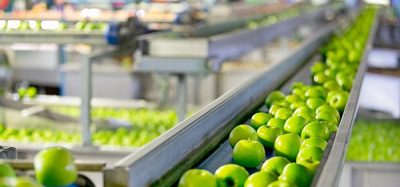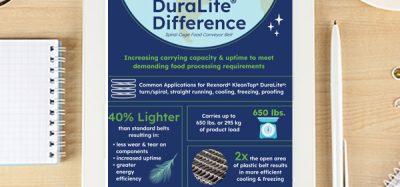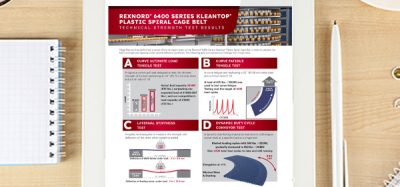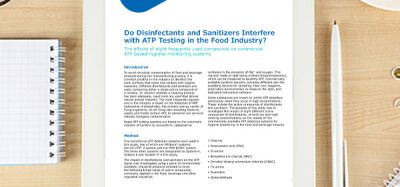Chemical treatment of stainless steel surfaces
- Like
- Digg
- Del
- Tumblr
- VKontakte
- Buffer
- Love This
- Odnoklassniki
- Meneame
- Blogger
- Amazon
- Yahoo Mail
- Gmail
- AOL
- Newsvine
- HackerNews
- Evernote
- MySpace
- Mail.ru
- Viadeo
- Line
- Comments
- Yummly
- SMS
- Viber
- Telegram
- Subscribe
- Skype
- Facebook Messenger
- Kakao
- LiveJournal
- Yammer
- Edgar
- Fintel
- Mix
- Instapaper
- Copy Link
Posted: 2 September 2014 | Gerhard Hauser, Chairman, EHEDG | No comments yet
In January 2014 the revised and completed 2nd edition of the EHEDG guideline Doc. 18 ‘Chemical Treatment of Stainless Steel Surfaces’ was published on the EHEDG website. The 1st edition (August 1998) had been prepared on behalf of EHEDG and 3-A. It dealt with ‘Passivation of Stainless Steel’. The attributes corrosion resistance and cleanability, which are the primary determinants of the material’s hygienic behaviour, rely upon the ‘passive layer’, a chromium-rich oxide film which naturally forms on all stainless steels and can be enhanced by chemical passivation procedures. This layer is adequately protective for the vast majority of food and beverage applications.
In the meantime, it proved necessary to integrate the procedures of ‘Pickling’ as well as ‘Electropolishing’ into the revised guideline as these chemical treatments are important surface treatments in addition to ‘Passivation’. They can help to assure the successful functional performance of stainless steels for product contact surfaces in the food and beverage industry. The revised document explains the general principles of those three processes – why they are necessary, when and how they should be applied, how they work and which chemicals are used. It shall mainly provide manufacturers and users of foodprocessing equipment and also regulatory authorities with essential practical information about chemical surface treatments applicable to stainless steels.
The following article shall provide further information of the content of the revised document.
Stainless steels with different contents of chromium, nickel, molybdenum and a number of other alloying play the most important role for process equipment in the food and beverage industries when chosen and treated in the right way. Corrosion resistance and cleanability of a functional stainless steel surface are mainly influenced by the surface properties topography, morphology and energy level. Implemented in the right way they are essential prerequisites of an effective passive layer upon the stainless steel which is in direct contact with the product and decisive for the hygienic condition.
Further preconditions for an effective passive layer are that the surface must be free from both physical and chemical contaminants. Mill-scale as well as all types of soils must be removed e.g. by liquid or vapour degreasers. Adjusted caustic detergents or hot alkaline solutions are mostly used for liquid cleaning. Organic solvents can be applied by spraying or swabbing. Embedded iron particles e.g. from poor workshop practices must be removed by an acid treatment appropriate to the extent of the contamination. After each of these treatments, the surface must be rinsed thoroughly.
Pickling
Requirements of the guideline on pickling are primarily addressed to equipment and plant manufacturers. For users of food-processing equipment it is important to be informed about the requirements for contract specifications. It should also be mentioned that there may be some differences in definitions of pickling and surface cleaning between Europe and the USA.
Pickling can be applied in the workshop of the equipment manufacturer as well as in the food company during installation e.g. welding is needed. The chapter contains essential practical information on this chemical procedure and the necessary preconditions.
Pickling is an acid treatment intended to remove a thin layer of usually 1 to 3µm of corrosion-susceptible material. Moderately used it does not affect the surface topography. Therefore, it is not intended to smooth stainless steel surfaces or rough welding seams. Nor is it intended to correct surface changes like grain deformation or modification which may have resulted from the cold forming of stainless steel components. For these, surface grinding may be more appropriate.
Pickling is mostly applied when the surface has been exposed to high temperatures in the presence of oxygen as e.g. during welding resulting in discolouration. However, pickling should not be confused with de-scaling, which means the removal of a thick, flaky oxide scale and all free iron from the surface. It should also not be confused with chemical passivation which will be explained later in detail.
During welding the localised heating mostly generates the clearly visible bands of colour, known as ‘heat tint’ on the weld and in the ‘Heat-Affected Zones’ alongside the weld. All surfaces with heat tint in excess have to be pickled. Even not easily visible welds, such as on the insides of pipework, should be pickled and chemically passivated before service if heat tint in excess cannot be avoided. Where the colour of the heat-tint is lighter than straw yellow (O2 content of the shielding gas lower than 40ppm: see EHEDG Doc 35), pickling may be considered unnecessary.
Pickling is not only used after welding. It can also be applied for removing fabrication residues such as iron oxides from surfaces. Ideally, equipment should be designed such that individual components can be pickled separately prior to assembly.
Mixtures of nitric and hydrofluoric acids are used for pickling which can be applied by tank immersion, circulation in pipe-work or by spray. For localised treatment of components brush-on pastes are also available. Attention has to be paid for elastomeric and plastic components of equipment because they can be damage by pickling acids.
After pickling the surfaces have to be completely rinsed. At this stage, they will be free of scale, free iron and exogenous foreign matter; meaning the surfaces are proven to be ‘clean’.
Passivation
The chapter Passivation defines important terms and contains essential information about the inert surface conditions of stainless steels. It is addressed to manufacturers and users of food-processing equipment and plants as well.
The passive layer on stainless steel surfaces is decisive for their corrosion resistance. It is a dense transparent layer of approximately 2-8nm thickness containing mainly chromium oxides but also e.g. iron oxides and ions. The quality of the passive layer is primarily determined by its chromium to iron ratio.
The term ‘passivation’ is used in different ways. The passive layer forms naturally and spontaneously on a clean surface (e.g. after pickling) when oxygen from air or water is available. In this guideline this process is called ‘natural passivation’. Thus, a satisfactory condition of the surface will be achieved for many common applications. If the passive layer is damaged, it re-forms also spontaneously under the influence of oxygen when the damaged area is clean. Damages can occur during manufacture or assembly of equipment (e.g. mechanical machining, welding and weld-repairs), by chemical and environmental conditions (e.g. the composition of the food, the use of abrasive or chlorine-containing cleaning substances) or by contamination during storage (e.g. contact with rusting carbon steels).
In addition, for particularly demanding applications, the strength (composition and thickness) of the passive layer and therefore the corrosion resistance can be improved by a chemical treatment called ‘chemical passivation’. It should be considered if a hazard analysis of the materials of construction, the food product, the cleaning regimes or the environmental conditions indicate that there is insufficient confidence in the natural passive layer.
The procedure for the chemical passivation of equipment contains in principle the surface preparation by cleaning and rinsing followed by the passivation process using an oxidising acid (mainly HNO3) and rinsing with water. In the guideline the procedure is described more detailed.
Chemical passivation of high-carbon stainless steels and some hardenable stainless steels using nitric acid is not advisable.
Citric acid as a non-oxidising acid does not itself form chromium oxides. By this reason it does not chemically passivate the surface. However, citric acid form iron complexes which diffuse the metal surface. Oxygen from the composition reacts with free chromium to chromium oxide. Thus, the passive layer can also be improved. In comparison to nitric acid, citric acid is a low hazard waste product.
Electropolishing
In this chapter, the guideline describes the electro chemical surface treatment of electropolishing which does not involve physical contact with the surface. It is achieved with electrochemical removals of material of at least 10 – 15μm. This process should not be confused with mechanical polishing.
Food and beverage processing equipment, as well as biotechnological plants, are sectors in which electropolishing may be advantageous for specific applications.
By electropolishing, topography, morphology and energy level of the surface of different metallic alloys can be optimised. It is a relatively-new procedure for improving significant functional properties. On one hand, the topography of grinded and mechanically polished surfaces will be smoothened and the Ra value diminished (for special requirements to e.g. Ra < 0.2μm). In comparison to other treatment procedures, the formation of optimal passive layers of austenitic stainless steels (improvement of the Cr/Fe-ratio and thickness of the passive layer) can be achieved to reach maximum corrosion resistance. Electropolishing also assists in the detection of defects such as cracks and pores by simple visual inspection. The guideline contains more detailed information on the advantages of electropolishing.
Electropolished surfaces must not be pickled as this would destroy the electropolished surface. In the case of installed electropolished tube systems, any welding processes must be particularly carefully carried out so as to minimise heat tint to a straw yellow colour or less (see: EHEDG Doc 35).
During electropolishing, anodic dissolution of metal ions takes place in a suitable electrolytic solution using an external direct current source. The dissolution depends on the distance between the anode (stainless steel equipment) and the cathode. For austenitic stainless steels phosphoric and sulphuric acids are normally applied as electrolytes.
A typical procedure for electropolishing consist of alkaline pre-cleaning with chlorine free detergents, rinsing with water, electropolishing according to calculated process parameters, rinsing with water, special acidic rinsing operation/possible chemical passivation, rinsing with water and drying. The electrochemical removal rate depends on current density and exposure time. The operations should be pre-defined and described in work instructions.
Process limits of electropolishing are geometrical dimensions (e.g. size of the baths). For material removals >100μm a combination with mechanical removal processes is recommended. Concerning installations (e.g. tube systems) electropolishing is only possible with increased effort and expense. Large surface areas or extensive components such as big vessels can be electropolished in situ by a mobile electropolishing technique. Repairing of defects from mechanical pre-treatment (e.g. scratches) is not possible by electropolishing alone.
Influences of chemical treatments on plastic and elastomeric materials
The last chapter of the guideline deals with the properties of plastic and elastomeric materials when they cannot be dismantled for chemical treatment procedures. In this case it must be ensured that all aspects are considered carefully. For example, at elevated temperatures some aggressive fluids can cause a much more marked effect on an elastomer than at room temperature. Physical properties, as well as fluid compatibility, need to be considered. Compression set, hardness, abrasion resistance, and thermal expansion can influence the suitability of a material for a particular application. It is recommended that users conduct their own tests to confirm the suitability of the selected material. In this case, a sample of the plastic material could, for example, be placed in the chemical solution using the applied concentration, temperature and time. Typical influences are described in detail within the guideline, which also provides a general estimation of approximate resistance of some elastomers to pickling and passivation procedures.
About the author
Dr. Ing. Gerhard Hauser has been a member of the European Hygienic Engineering and Design Group (EHEDG) since 1989. He is currently Chairman of the EHEDG subgroups ‘Chemical Treatment of Stainless Steel’ and ‘Hygienic Design of Bakery Equipment’. He lectures on hygienic design at conferences and seminars and has published two books on Hygienic Design with Wiley VCH Publishers. Gerhard was formerly Senior Engineer at the Munich University of Technology, Chair of Mechanical Engineering and Member of the German mirror body for the European Machinery Directive.








